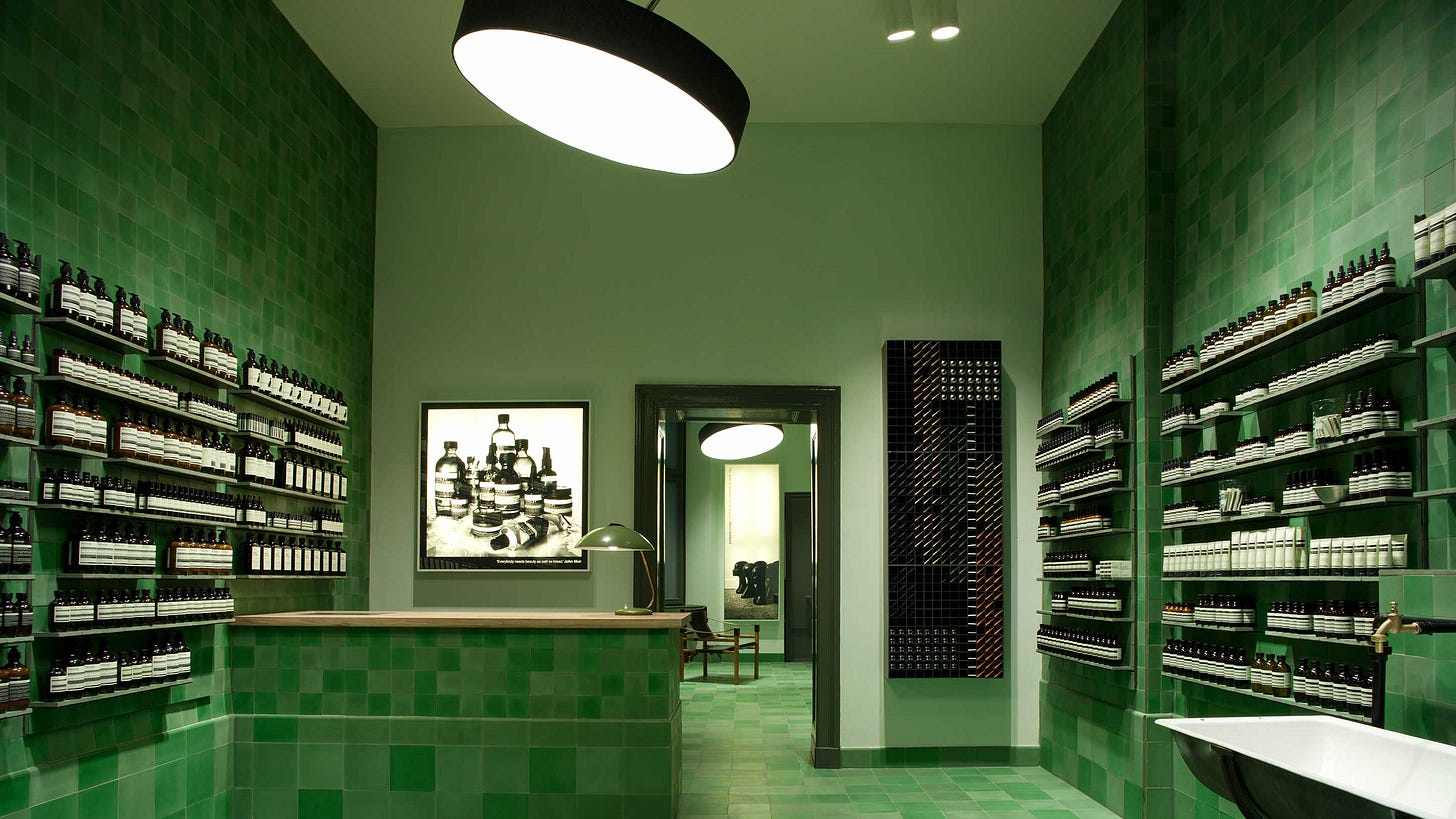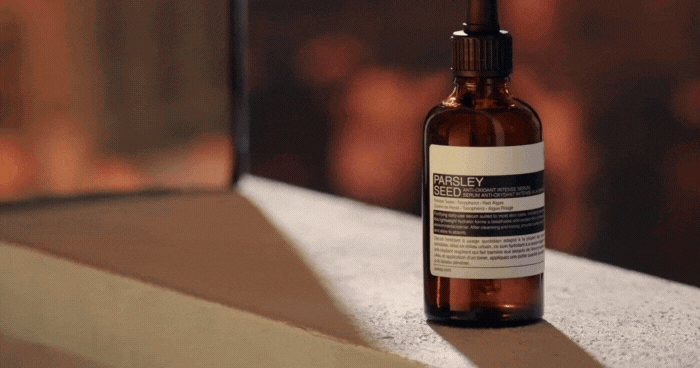🏛️ Case Study: AESOP - Marketing as a form of art
What happens when brands whisper instead of shout? The cosmetics brand Aesop shows how a coherent brand identity, calm communication, and modern store design can achieve cult status.
Hi 👋 I’m Florian Schleicher. This is the FutureStrategies newsletter. Thank you so much for reading along 💚
There are brands you want to own. And there are brands you want to understand. Aesop is one of the few brands that achieves both.
Never heard of the brand?
Then you’re either not the target – or about to become obsessed.
A few hard facts:
280 signature stores worldwide, an annual growth rate of 30-40%, a brand value of US$2.5 billion, and a cult-like love for the company among its target audience.
Aesop is one of the most coveted brands in the world.
“No matter where and how you first meet the Aesop brand it will strike you as the prototype of a modern beauty brand.”
JP Kuehlwein, Uberbrands
Aesop is not a traditional cosmetics brand.
It is a feeling. A space. A story. A ritual.
It whispers where others shout.
It makes a niche audience feel deeply understood.
Perhaps I am so fascinated by it because it was born in the same year as me—1987. But perhaps also because it does many things differently, goes its own way—and does a lot of things right.
But how does it do that? What makes this brand so special?
Today we will explore it through these topics:
Brand identity over performance
POS Cathedrals of tranquility
Quiet sustainability
And finally, 3 key lessons we can learn from the Aesop brand for our own marketing strategies.
💆 Identity over performance
Like many unique brands, the story of Aesop did not begin with a business plan, but rather with dissatisfaction. Dennis Paphitis, a hairdresser with Greek roots living in Australia, was annoyed by the synthetic scents and exaggerated promises of conventional care products.
So he began mixing alternatives in his own salon in Melbourne. High-quality ingredients, understated packaging, no exaggerated claims. Just effectiveness, aesthetics, tranquility.
Even the name “Aesop,” after the ancient fabulist of the same name, is a subtle, almost provocative counter-reaction to an industry that stages its products in a meaningful but superficial way.
While classic cosmetics brands fight for attention—shouting loudly and colorfully—the brand dispenses with discounts, celebrities, and garish advertising messages.
Instead, the company invests in sensual store architecture, literary language, and radical consistency.
You can read my previous marketing case studies here:
Apple, LEGO, Patagonia, Oatly, Reformation, Too Good To Go
In times of obsession with quick results and ubiquitous advice promising “Results in 7 Days” or “Clinically Proven,” Aesop responds differently.
No hype.
No discounts.
No promises of a glowing complexion.
Instead: texts featuring quotes from Camus, stores designed like architectural poems, and marketing channels based on emotions.
A product needs to perform, but if it can do so with a little poetry, so much the better. Technology increasingly robs us of the “mystical” in our lives, but not everything needs to be fast, available, and convenient. I like ideas and products that reveal themselves slowly – more whisper than scream, something that becomes part of our own personal universe.
Dennis Paphitis, Gründer AESOP
And so the brand is less concerned with promoting the company and more with the consumers' own identity, with the products positioning themselves as a mirror of that identity.
Visitors to the website will find no superlatives, no beauty promises, no inauthentic missions. Instead, they will find factual descriptions, clear language, and short sentences.
The products are not touted, but explained. There are no “secret formulas” or perfectly styled models.
The focus is on ingredients - often plant-based, with information on their origin, effects, and application. This creates trust not through image, but through information.
This attitude runs through all communication channels.
Their Instagram is not dominated by product images, but by architectural photographs, literature lists, and design objects. Aesop is not hunting for new followers. Their channel is warm, dark, poetic, and with a strong focus on architecture. No influencers.
This perfectly appeals to the target group, a modern, affluent, intellectual “cultural cohort” that wants to use sophisticated but unpretentious products and be admired for their connoisseurship.
“They believe in- and identify with Aesop and use their choice to clearly differentiate versus their nemesis, the ‘nouveau riche’ and their primitive, showy and wasteful consumption. To them Aesop is the antithesis of the trophy luxury or lifestyle brand of the shallow masses. To them, Aesop is cult and they are willing disciples.“
JP Kuehlwein, Uberbrands
The brand's newsletters focus on seasonal routines, plant-based ingredients, and reading recommendations, not discounts.
Even their online magazine “The Fabulist” avoids any direct reference to products: it brings together essays – highly recommended here is “Life Finds A Way” by Zadie Smith – conversations, book recommendations, and travel observations.
And small cultural events are regularly held in selected stores, such as readings, discussions, and micro-exhibitions. As part of its “Resonant Gestures” program, Aesop invited local musicians to play small live sets in several stores in 2023. The performances were deliberately timed to complement the store visit. Music thus became an extension of the spatial experience, an inviting gesture for deceleration and cohesion.
These cultural interventions are part of brand management, small architectural but passionate designs that challenge the interchangeable beauty routine.
🏛️ POS as cathedrals of tranquility
When you walk into an Aesop store, you don't find a cosmetics shop, but a space that evokes emotions. It's no surprise that Vogue calls the stores the dream of every (in)official interior designer.
Each store is unique—designed by local architects, inspired by the surroundings, crafted with the aim of interpreting rather than replicating. In Oslo, you'll find Norwegian slate, and in Kyoto, wood from old townhouses.
You don't recognize Aesop by a logo above the door, but by the tranquility of the space, by the way the light falls.

This store design is not a question of aesthetics.
It is part of brand management. The spaces are minimalist, well thought-out, almost sacred.
They say nothing about the product, but everything about the brand's self-image.
“Our stores and counters are a clear communication of our values and our approach to retail service. We think of it as a hosting experience. The store is a welcoming, calm space where you are treated as a guest in our home, with high quality products, unobtrusive service, and a comfortable space that appeals to all the senses.”
Retail Architectural Manager Denise Neri in PURVEYR
Those who enter here are not relegated to being a target group, but are invited to interact as thinking, feeling human beings.
Every store can be rediscovered.
And I experience this in my own shopping behavior.
For convenience, I prefer to order most things online. But for my Aesop purchases, I always like to go to the store. Even when traveling. And even if I don't need a product right away, I like to go in, admire the store design, wash my hands, and take a quick breather.
This is something the brand deliberately controls:
“It is about the pleasures the products can give, and the need for that to be part of a person’s everyday experience. And it takes time to shop, that’s the truth – we live in an era where we are extremely deprived of time. So when somebody enters here, indeed, every sense should be cared for and experienced because it’s their precious time.”
Suzanne Santos, Chief Customer Officer Aesop
The feeling that remains:
I'm not just buying soap here.
I'm buying a piece of peace.
With excellent and empathetic advice, because
“Aesop is about a conversation between two people.”
Suzanne Santos
If you've never been to an Aesop store, this video summarizes the experience in a very entertaining way:
 Tiktok failed to load.
Tiktok failed to load.Enable 3rd party cookies or use another browser
🌱 Quiet Sustainability
Aesop rarely talks about sustainability.
And that's precisely what makes the brand credible. But it also poses a problem.
Let's start with the positive aspect:
While others advertise with seals, initiatives, and CO₂ figures, at Aesop, sustainability is not a campaign theme, but a fundamental attitude that permeates everything.
Aesop has been B Corp-certified since 2020. But instead of aggressively marketing this label, it is mentioned only in passing. Much more important is how this attitude manifests itself in concrete terms:
In refill stations that are being expanded worldwide. In stores built with locally recycled materials. In 100% cruelty-free products or packaging that is almost entirely made from recycled raw materials.
At Aesop, sustainability is not a promise, but a matter of course.
But that is precisely why there is still a lot of room for improvement when it comes to communication around sustainability and green marketing: Aesop is strict internally, but visible references are often missing in direct product marketing. As a lifestyle brand, it has a role model effect that is not being exploited.
If Aesop communicated its green credentials more effectively, its followers and consumers would recognize what the brand stands for. And, similar to Apple and its sustainability efforts, this would have an enormous impact on consumer behavior and the market.
🏆 3 Key Learnings for Strategic Marketing
Here are my three takeaways from the Aesop case study for our own strategic marketing:
1. Reduction to the essence
Aesop consistently refrains from traditional advertising, influencers, discounts, and promises of radiance. In an overloaded industry, this creates a sense of clarity and trust. Those who make fewer claims are remembered more strongly. The marketing strategy is consistent: they have filtered out a brand essence and infused it with ideas.
2. Experiences replace efficiency
Aesop stores are not traditional points of sale, but well-designed, architectural spaces that offer an experience. Advice becomes a conversation, shopping becomes a moment of deceleration. And that's exactly why people go there – even if they don't need anything. And then they leave the store with a new product after all.
3. Clear target group focus
Aesop appeals to a culturally affluent, style-conscious community – and deliberately ignores the mass market. This sharp positioning creates appeal and loyalty. The brand polarises – and benefits precisely from this. By focusing on a target group, accurate campaigns and ideas can trigger emotions.
➡️ Do you also want to excite your audience like Aesop? ⬅️
If you want to develop a strategy for your company that excites your target audience and really works, then let's talk.
I have been creating inspiring marketing strategies for corporates, political decision-makers and start-ups since 2008. With my marketing studio FutureStrategies, I currently work with clients from 11 countries.
🕵 Why Aesop’s approach resonates today
Because consumer culture is changing radically and the brand fits in perfectly with this.
According to a McKinsey study, 71% of Gen Z want “brands that respect them as individuals.” 64% are looking for brands that are culturally relevant—not promotional.
Aesop captures this zeitgeist perfectly. The brand offers no promises, but rather a projection screen for self-image, style, and attitude.
And it responds to another consumer desire: slowing down.
Aesop stores are places where you can slow down. And the minimalist, respectful communication fulfills a desire for guidance in an overloaded market—for a specific target group.
Aesop doesn't sell cosmetics.
Aesop sells the feeling of being understood.
Not as a target group, but as a person.
And not for everyone. But for a select group.
And maybe Aesop is simply what brands could be if they dared to stand by their brand essence.
Thanks for reading,












Loved this! The way they design their stores influenced by the city and surroundings is my fave thing about Aesop.